As someone who’s always wanted to build web applications and software programs, I found myself scouring the internet for the most efficient way to learn HTML and CSS—the building blocks of the internet. After browsing various online platforms, I stumbled upon a highly recommended course by Brad Traversy promising to take beginners like me from novice to proficient in just a few months.
Excited by the prospect of designing websites, I purchased the digital download. Within seconds, I had the entire course at my fingertips, ready to start learning at my own pace from the comfort of my home.
My case isn’t a unicorn; it’s quite the norm in today’s digital age where learning new skills, enjoying entertainment, or obtaining software can happen at the click of a few buttons. For creators, digital downloads open up a global market; they can sell their products anywhere and anytime without needing physical production, inventory, or logistics.
Consumers, on the other hand, enjoy the convenience and immediacy of accessing products. They can purchase and use digital goods instantly, often with the ability to access them across multiple devices.
In this guide, you’ll learn:
- What digital downloads are
- Why online creators are creating digital downloads;
- Today’s most popular digital downloads; and
- How you can use them to grow your business.
What are digital downloads?
A digital download is the electronic transfer of data or files from a server to a user’s device, typically over the Internet. These files can be any form of digital media that people can download and use immediately. Common examples include:
- eBooks and PDFs
- Software applications
- Music and audio files
- Video games
- Online courses, etc.
Read more: What is a Digital Product: Understanding the Basics for 2024
Why online creators are creating digital downloads
Many online creators are now using different kinds of digital downloads to increase brand awareness and generate extra revenue for their businesses. Here are some reasons why digital downloads are beneficial for these creators:
-
Reduced overhead
Digital products eliminate the need for physical components like packaging, printing, and shipping, which incur substantial costs of physical goods. There’s also no need to manage inventory levels, worry about unsold stock, or face the risks associated with overproduction.
This not only simplifies the business model, allowing creators to focus more on product development and marketing, but it also allows them to offer products at a competitive price while maintaining higher profit margins.
-
Global reach
By selling digital products, creators can access customers from around the globe without the limitations of physical store locations or traditional distribution channels. This global reach is particularly valuable for niche products that may have a limited audience in a particular geographic area.
Also, digital stores built with platforms like Thinkific, WooCommerce, and Shopify are always open, so creators can make sales at any time of the day. This maximizes their revenue opportunities across different time zones.
-
Instant delivery
Since there’s no waiting period for shipping, digital downloads provide instant gratification to customers, which is a strong selling point. This gratification can also encourage impulse buying, which increases the likelihood of additional purchases and lowers refund rates.
-
Scalability
Unlike physical goods that require additional resources to produce more units, digital products can be duplicated indefinitely at no extra cost. This means that whether the creator sells one or 1,000 copies, the cost to deliver the product remains virtually unchanged.
This scalability makes digital products particularly lucrative as they can continue generating revenue with minimal ongoing effort and investment.
-
Easier updates and improvements
Creators can update their digital products over time to fix bugs, improve functionality, or add features, without needing to recall the items or disrupt the distribution process (as they’d need to with physical products). They can roll these updates out to all users simultaneously, ensuring that everyone has the best and latest version.
Regular updates not only improve the product but also keep the user base engaged. They provide a reason for customers to come back, cultivating loyalty and potentially generating more sales through cross-promotions.
-
Long tail marketing
Digital downloads enable creators to profit from niche markets. Since the costs of serving additional customers are low, it becomes economically viable to offer products that appeal to small, specialized interest groups.
Also, unlike physical goods that might be phased out of stores due to shelf space constraints, digital goods can remain available indefinitely. This long availability can continuously attract new customers who discover the product long after its initial release.
Top 10 most popular digital downloads in 2024
If you’re not sure which digital downloads to create for your audience, here are some of the most popular ones to choose from:
-
eBooks and audiobooks
Many online creators and businesses use eBooks and audiobooks as powerful marketing instruments that enhance brand visibility, establish authority, and generate income. In fact, the worldwide eBook market is expected to generate a revenue of $14.61bn (USD) this year.
I have found many businesses by reading some of the eBooks they’ve created. For example, I got to know about Pipedrive by downloading and reading its eBook on building an email list. The company has other sales and marketing eBooks that it uses to draw attention to the paid software it provides.
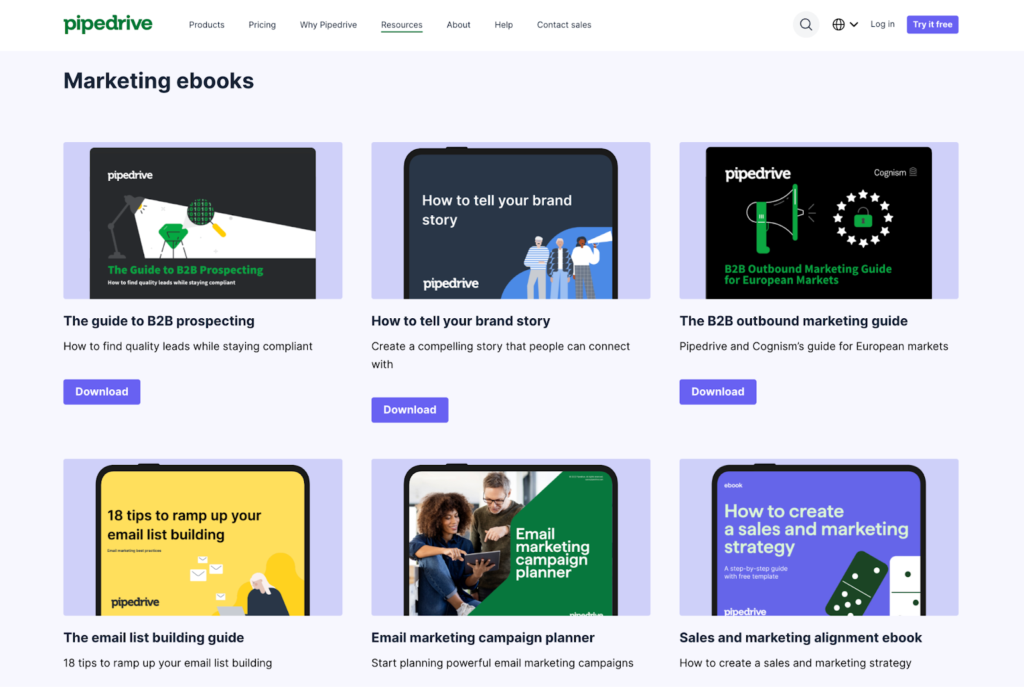
As an online creator, there are many ways to add eBooks and audiobooks to your repertoire of offerings. For example, if you’re a career coach, you could publish an eBook titled Resume Secrets Revealed and an audiobook titled Interview Mastery, attracting job seekers and upselling personalized coaching sessions. Or if you own a wellness brand, you could release 30 Days to Better Health, an eBook and audiobook series, which leads to subscriptions for your full wellness programs.
Here’s what selling eBooks and audiobooks can do for you:
- Lead generation. You can offer a free chapter or summary audiobook as a lead magnet to encourage potential customers to provide their contact information.
- Content marketing. Your eBooks and audiobooks can provide substantial and valuable content to help you build a relationship with your target audience and position yourself or your business as an authority in your industry.
- Cross-promotion opportunities. Your eBooks and audiobooks can include references to other services and products you offer, serving as a softsell or a direct call to action.
Income generation
You can generate direct income and diversify your revenue streams by selling your eBooks and audiobooks through your website or marketplaces. You can also bundle these resources into a subscription model, providing regular content for a recurring fee, which ensures steady revenue.
Many businesses use eBooks and audiobooks as entry-level products that lead customers to more expensive offerings, such as courses, seminars, or premium services.
-
Online courses and webinars
If you’re aiming to share knowledge, showcase your expertise, and drive revenue and customer engagement, creating online courses and hosting webinars are a great way to achieve all this.
For example, say you’re a digital marketing expert who has built a reputation through your insightful blog posts and social media presence. To further provide value to your audience, expand your reach, and monetize your expertise, you can develop a series of online courses titled Digital Marketing Mastery, and regular live webinars discussing emerging trends in social media marketing. You can then market these offerings by providing free introductory webinars and teaser lessons, which funnel interested participants into your paid courses and exclusive webinar series.
Ellie Diop, the founder of the Ellievated Academy, did this with her business. Instead of relying solely on the 1:1 sessions she provided, she used Thinkific to create and host a bunch of online courses teaching people how to make money, grow businesses, and attain financial freedom. These courses helped her earn multiple 7-figures and get featured in reputable publications like Forbes, Business Insider, Inc.com, and Black Enterprise.
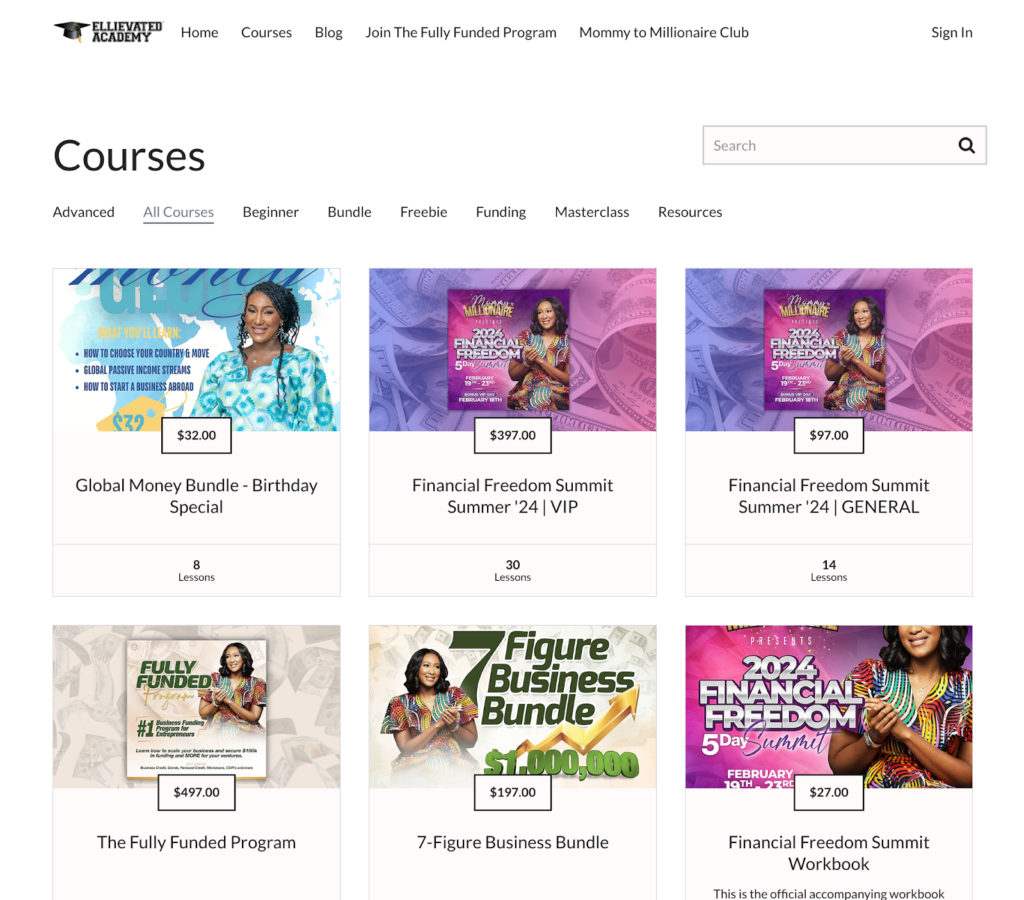
Read: How Ellie Talks Money Made 7 Figures In Less Than a Year
Here’s what online courses and webinars can do for your business:
- Expertise and credibility. Online courses and webinars allow you to dive deep into subjects, showcasing your knowledge and establishing credibility in your field.
- Community building. These digital downloads facilitate direct interaction between you and your target audience. Your students can ask you questions, receive personalized feedback, and engage with other learners, which fosters a deeper connection to your brand.
- Content repurposing. You can repurpose content from your courses and webinars into various formats like blog posts, podcasts, eBooks, and even social media content, maximizing the reach and utility of the material.
Income generation
You can sell individual courses and webinars or offer them as part of a subscription mode, ensuring a steady income stream from committed learners. You can also offer different levels of access or bonus content at varied price points (tiered pricing models) to cater to a broader audience, from budget-conscious learners to those seeking intensive training.
If you offer higher-tier products like advanced courses, private coaching, or premium memberships, you can use courses and webinars to introduce your target audience to these comprehensive offerings.
-
Video tutorials
Offering video tutorials as digital downloads is a versatile and potent way for you to educate, engage, and connect with your audience. For instance, if you’re a personal trainer or fitness influencer, you can create a video series such as 30-Day Workout Challenge or Yoga for Beginners that users can download and follow at their own pace.
If you’re a chef or food blogger, you can offer tutorial series on specific cuisines or cooking techniques, ranging from short recipe videos to comprehensive cooking tutorials covering entire culinary skills. Or if you’re a tech expert, you can produce short videos on software usage, coding languages, or gadget reviews, catering to both beginners and advanced users.
Here’s how you can use video content and tutorials to build your brand:
- Engagement and retention. Video content is highly engaging and has been shown to increase retention rates significantly compared to text-based content. Tutorials and instructional videos capture the audience’s attention effectively, making them excellent tools for explaining complex concepts, demonstrating products, or teaching skills.
- Visual appeal. Videos provide a visual and auditory experience, which is more appealing to users who prefer watching over reading. This can increase your users’ connection to you, as videos can convey your personality and authenticity more effectively.
- SEO benefits. Platforms like YouTube are heavily indexed in search results and having video content hosted there can drive organic traffic to your website or online store. Also, videos keep visitors on a page longer, which can positively impact SEO rankings.
Income generation
You can sell access to your video tutorial directly from your website or through online learning platforms. This can be a substantial source of revenue, especially if you’re in a niche industry or offer specialized skills. You can also include your video content in a subscription-based model where users pay a recurring fee for continuous access to a library of videos.
If you’re posting your content on YouTube, you can apply to the Partner Program so ads can appear on your videos. If your content is popular, you can leverage your viewership numbers to attract sponsor deals that complement your content and audience.
-
Digital art and graphics
If you’re a designer or business owner in the creative arts, you can create digital art and graphics for your target audience. These products range from individual art pieces and designs to comprehensive graphic templates and packages. For example, if you specialize in corporate branding, you could create logo templates, business card designs, and corporate identity kits that businesses can customize. An example might be a Startup Branding Bundle tailored for new businesses.
If you focus more on website and social media, you could create pre-designed templates for websites, Instagram posts, or Pinterest graphics that bloggers and online marketers can use to enhance their digital presence. Or you can make some high-resolution printable artwork that customers can use for home decor, stationery, or personal projects. Designers often sell themed collections such as Minimalist Home Office Art.
Here’s what creating digital art and graphics can do for your business as a designer:
- Showcase of skills. Selling digital art and graphics allows you to showcase your unique style and creativity, attracting clients who appreciate and seek your specific aesthetic.
- Lead generation. Offering freebies or graphic samples can attract traffic to your website or online store, which helps you capture leads and build an email list for future marketing campaigns.
- Brand development. You can strengthen your brand identity by consistently providing high-quality, distinctive digital art. This helps you build a loyal following and establishes you as a reliable source for premium digital graphics.
Income generation
You can sell your digital art and graphics directly through your own website, third-party marketplaces, or creative platforms like Etsy, Creative Market, and Envato. You can also license your work to generate ongoing income from the same piece of digital art when multiple clients use it.
Offering bundled graphics packages or entire sets of themed artwork can appeal to businesses looking for cohesive visual content; this enhances your value proposition and increases sales (and average order value).
-
Stock images
Stock images are essential resources in the digital content landscape, serving as crucial elements for designers, marketers, bloggers, and businesses of all sizes on their websites, advertisements, and presentations. If you’re a photographer, selling stock images can be a great way to build your brand and earn an income.
Here’s why:
- Enhanced visual content. Strong visual content is more engaging and can significantly increase user interaction and retention on digital platforms.
- Cost-effective branding. Small businesses and startups often lack the budget for custom photoshoots. Stock photography allows these companies to improve their branding with affordable, yet professional images.
- Content marketing support. Blogs, social media posts, and online articles often need accompanying imagery to make the content more appealing and shareable. Stock images allow content marketers to spice up their online content without having to pay too much money.
Income generation
You can either sell your photos through your website or stock image websites like Shutterstock, Adobe Stock, or Getty Images, earning royalties each time people download your images.
You can also specialize in niche markets (e.g. drone photography, rare wildlife images), which often command higher prices due to the specialized nature of the content.
-
Templates
Templates serve a practical need by providing structured and professionally designed frameworks that users can easily customize for their specific purposes. There are different kinds of templates, including:
- Business templates. These include business plans, marketing proposals, invoices, and email templates, which are essential for small business owners, entrepreneurs, and corporate managers who need to create polished and professional documents quickly.
Here are some business templates on Microsoft Create:

- Resume templates. These are particularly beneficial for job seekers looking to make a strong impression in their job applications and are offered in various styles and formats to suit different industries and career levels.
Here are some resume templates on Canva:
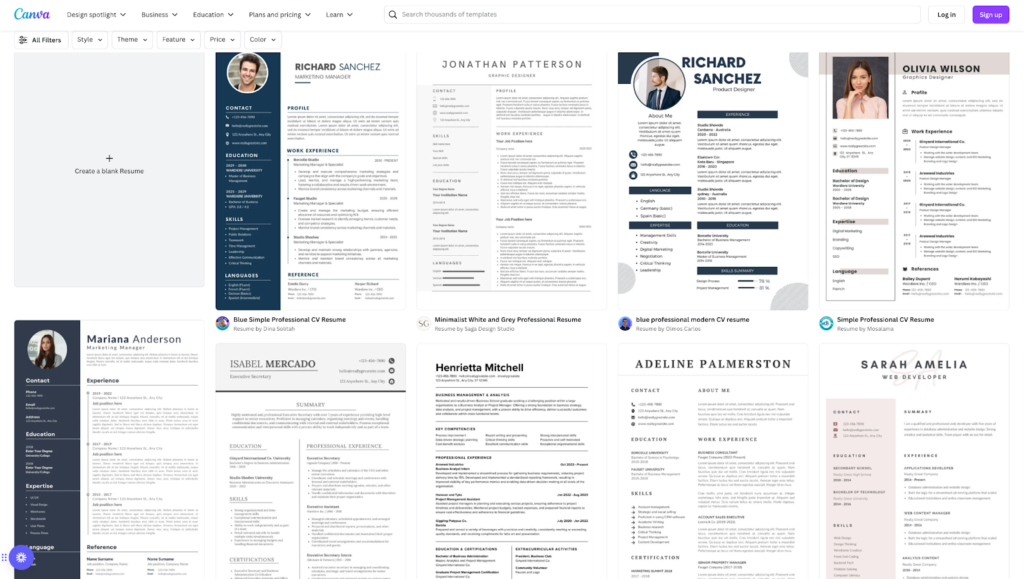
- Presentation templates. These are used for everything from academic lectures to business pitches and are designed to make presentations more visually and engaging.
Here are some downloadable presentation templates from 24 Slides:
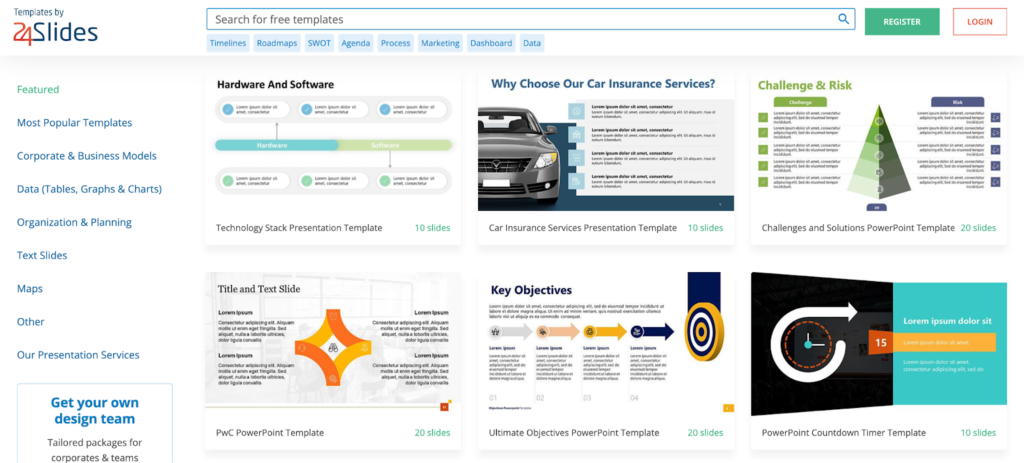
Here’s what creating templates can do for your business:
- Niche marketing. With templates, you can target specific niches, such as creative industries, tech startups, or educational professionals, tailoring your designs to meet the unique needs and preferences of these groups.
- Brand consistency. If you have employees, providing them with templates ensures that all external-facing documents and presentations are consistent with your company’s branding.
- Lead magnets. You can use free templates as lead magnets to capture email addresses and build a mailing list. You can nurture this list with additional content, updates, and offers, converting leads into customers over time.
Income generation
You can sell your templates individually or in bundled packages via your website or through platforms like Etsy, Creative Market, or TemplateMonster. You can also offer subscription services that provide access to an extensive library of templates with regular updates and new additions.
Or you can use the freemium pricing model where you offer basic templates for free and charge more for advanced or premium versions.
-
Music and audio files
While Spotify is now the go-to place for musicians, indie or not, to distribute their work and engage with audiences worldwide, you can still offer up your work as digital downloads, especially if you don’t make “conventional music”. These digital downloads can include individual tracks, albums, sound effects, beats, and even comprehensive sample packs.
You can also get on platforms like Patreon, which allows artists to provide exclusive content such as behind-the-scenes tracks, early releases, or unique remixes to their subscribers.
Here’s what this can do for your brand:
- Wider audience reach. Digital downloads make it possible for you to reach global audiences far beyond local venues or regional boundaries, which is especially helpful if you’re an independent artist or small label seeking to expand your listener base.
- Direct fan engagement. Selling music directly to your fans via your personal website or platforms like Bandcamp strengthens the artist-fan relationship. It allows you to engage more personally through exclusive releases or bonus content for downloads.
- Cross-promotion through merchandise. You can bundle digital tracks with physical merchandise or special edition releases (like Chappell Roan does here with tee shirts, keychains, hats, and stickers), increasing brand visibility and creating a holistic fan experience.

Income generation
If you sell music directly through your own channels or digital platforms, you can retain a larger share of the revenue compared to traditional distribution methods, which often involve multiple intermediaries.
Beyond one-time sales, you can also monetize your digital tracks through streaming platforms and licensing deals for use in films, advertisements, and other media. Or you can offer a subscription model where your fans pay a recurring fee for regular content releases, such as exclusive tracks, live session recordings, or first access to music.
-
Printable planners and journals
If you create content or software to help people boost their productivity, why not create and sell printable planners and journals as digital downloads? These products combine the personal touch of traditional paper planning with the convenience of digital access, making them a valuable asset for users aiming to increase their productivity and mindfulness.
Printable planners and journals often include various templates for daily, weekly, and monthly planning, as well as specialized pages for tracking habits, budgeting, meal planning, and more. Some journals may feature prompts for reflection, gratitude, or goal-setting, which support mental well-being and personal growth.
Here’s what selling printable planners and journals can do for your brand:
- Targeted niches. You can market your planners and journals to specific groups, such as students, teachers, entrepreneurs, or fitness enthusiasts, tailoring the content to the unique demands of each niche.
- Lead magnets. Offering a free printable page or a mini-journal can attract potential customers to your website or online store, encouraging them to sign up for newsletters and learn more about your other offerings.
- Community building. You can build a community around your products by hosting challenges, sharing tips on social media, or creating forums where users can share their journaling experiences and planner layouts.
Income generation
You can sell these printable products directly on your website or through online marketplaces like Etsy or Gumroad, packaging them with complementary products like stickers or tutorial videos.
You can also bundle different types of planners and journals together, or offer seasonal or thematic bundles to appeal to users looking for comprehensive planning solutions.
-
Free software tools
Many businesses, especially those that offer software products, create free tools as a gateway to their paid offerings. The idea is to provide potential customers with free value, so they become willing to purchase the paid products.
Thinkific takes this approach with its free plan. On the free Thinkific plan, users can create one course, one community, one live event, and one digital download, among other things. But that’s not where the value ends. Thinkific also created free AI creator tools like a business name generator, course name generator, and course outline generator to make it easier for creators to run their businesses.
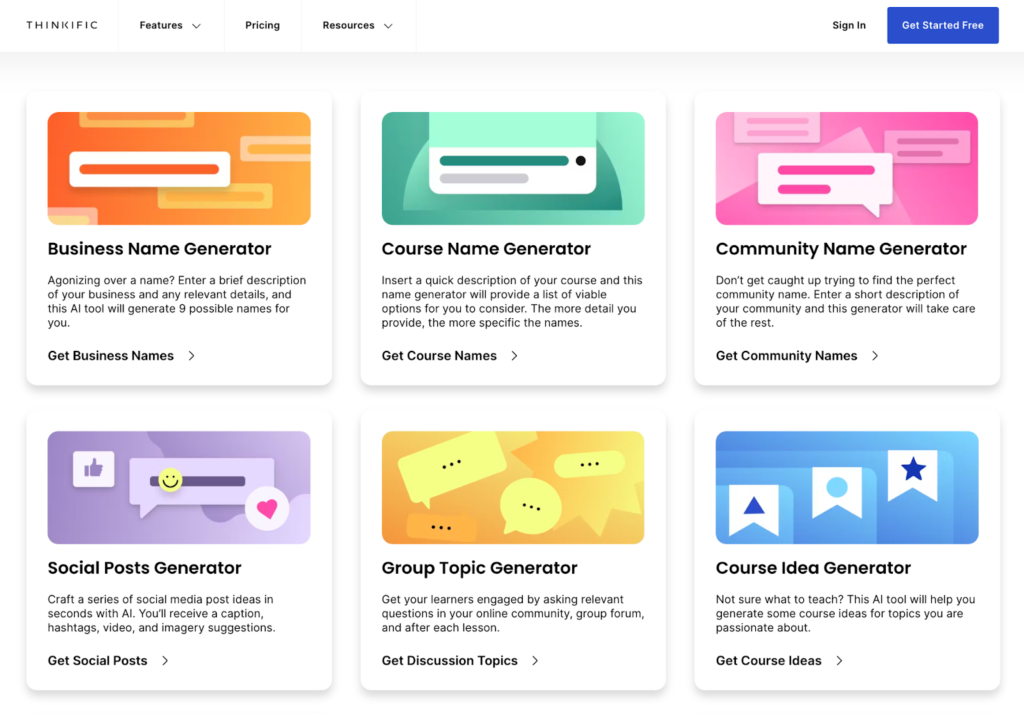
There are many ways you can use free apps/tools to boost your business growth. For example, if you specialize in graphic design software, you could provide a free logo maker tool, which entices users to explore more sophisticated design solutions offered in the full version. If you’re an educational tech company, you can release a free basic quiz app that teachers can use in their classrooms, with the option to upgrade to a more comprehensive educational platform featuring detailed analytics and curriculum integration.
Here’s what offering free apps/tools can do for your business:
- Lead generation. Users who sign up for the free tool provide their contact information, which you can use for targeted marketing and follow-up communications to promote the full version.
- Product showcase. Free tools allow potential customers to experience your software without financial commitment, reducing the barrier to entry and enabling them to see the value of the full product.
- Brand loyalty. By providing value through free tools, you can build trust and loyalty, which are crucial for long-term customer relationships users who find your free tools useful are more likely to consider purchasing full versions or recommending the software to others.
Income generation
The freemium model is popular in the software industry, where basic functions are free, but more advanced features require a paid upgrade. This is effective at converting free users into paying customers. Once a user is within the ecosystem (through your free tool), you can send targeted offers for upgrades or additional services.
The data you collect from free tools can also provide valuable insights into customer behavior, preferences, and needs. You can use this data to refine your marketing strategies, improve product offerings, and personalize the user experience to increase conversion rates.
-
Membership sites
Suppose your focus is to build a dedicated community and establish stable, recurring revenue streams. In that case, you can set up a membership site where you offer exclusive content, community features, and regular updates in exchange for a recurring fee.
Remember Ellie Diop who created a bunch of courses teaching people how to make money and grow their businesses? She also created a membership site called The Millionaire Mommy Club, which gives members access to all her current and future online courses, private coaching sessions, and exclusive mentorship in exchange for a monthly or yearly fee.
You can offer many things on your membership site: tutorials, live Q&A sessions, behind-the-scenes footage, monthly webinars, 1:1 mentoring sessions, community-driven projects, and contests.
Here’s what this does for you:
- Loyal subscriber base. Offering unique content that is not available elsewhere makes your subscribers feel special and more loyal to your brand.
- Community building. Membership sites often come with community features like forums, member directories, and interactive events, cultivating a sense of belonging among members, and encouraging ongoing engagement and retention.
- Personal brand enhancement. Your membership site serves as an extension of your personal brand, enabling you to deepen your relationships with your audience.
Income generation
Membership sites run on a subscription model by default, which provides a consistent, predictable income for you. As your community grows, so does the potential revenue. You can scale your offerings by adding more content and higher pricing tiers or offering affiliate products that resonate with your audience’s interests.
Besides the primary subscription revenue, you can also include add-ons like exclusive merchandise, special event tickets, or additional services for higher-tier members, further diversifying income.
Read: How to Price Your Membership Site to Maximize Profits
Create and sell digital downloads with Thinkific
From eBooks and online courses to practical templates and free tools, digital products meet a broad spectrum of consumer needs while offering you flexible and lucrative ways to market and monetize your expertise.
Whatever digital download you want to offer, Thinkific is here for you! Thinkific gives you all the tools you need to build an online course that caters to your target audience, whatever their preferred learning style may be–course templates, different content formats (text, video, audio, images, downloads, etc.) a drag-and-drop course builder, cohort courses, live lessons and webinars, quizzes, exams, and more.
But it does more than that.
Thinkific also gives you everything you need to build websites, create and sell digital downloads, build learning communities and membership sites, host live events, and do 1:1 coaching sessions, among other things.
Sounds neat, eh? Sign up for our 14-day free trial to explore Thinkific’s features.





